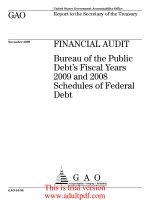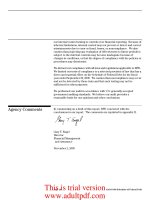United States Government Accountability Office GAO November 2010 Report to the Chairman, United States Securities and Exchange Commission|_part2 pdf
Bạn đang xem bản rút gọn của tài liệu. Xem và tải ngay bản đầy đủ của tài liệu tại đây (251.59 KB, 10 trang )
information systems and over financial reporting and accounting
processes may adversely affect information used by SEC’s management
that is based, in whole or in part, on information that is inaccurate because
of these weaknesses. In addition, unaudited financial information reported
by SEC may also contain misstatements resulting from these weaknesses.
We considered the material weaknesses identified above in determining
the nature, timing, and extent of our audit procedures on SEC’s fiscal year
2010 financial statements. We caution that misstatements may occur and
not be detected by our tests and that such testing may not be sufficient for
other purposes.
These material weaknesses are discussed in more detail in appendix I to
this report. We will be reporting additional details concerning these
material weaknesses separately to SEC management, along with
recommendations for corrective actions. We also identified other
deficiencies in SEC’s system of internal control that we do not consider to
be material weaknesses or significant deficiencies but which merit SEC
management’s attention and correction. We have communicated these
matters to SEC management informally and as appropriate, will be
reporting them in writing to SEC separately.
Our tests of SEC’s compliance with selected provisions of laws and
regulations for fiscal year 2010 disclosed no instances of noncompliance
that would be reportable under U.S. generally accepted government
auditing standards. The objective of our audit was not to provide an
opinion on overall compliance with laws and regulations. Accordingly, we
do not express such an opinion.
SEC’s Management’s Discussion and Analysis, required supplementary
information, and other accompanying information contain a wide range of
information, some of which is not directly related to the financial
statements. We did not audit and we do not express an opinion on this
information. However, we compared this information for consistency with
the financial statements and discussed the methods of measurement and
presentation with SEC officials. On the basis of this limited work, we
found no material inconsistencies with the financial statements, U.S.
generally accepted accounting principles, or Office of Management and
Budget Circular No. A-136, Financial Reporting Requirements.
Compliance with
Laws and Regulations
Consistency of Other
Information
Page 7 GAO-11-202 SEC's Financial Statements for Fiscal Years 2010 and 2009
This is trial version
www.adultpdf.com
SEC management is responsible for (1) preparing the financial statements
in conformity with U.S. generally accepted accounting principles; (2)
establishing and maintaining effective internal control over financial
reporting, and evaluating its effectiveness; and (3) complying with
applicable laws and regulations. SEC management evaluated the
effectiveness of SEC’s internal control over financial reporting as of
September 30, 2010, based on the criteria established under FMFIA.
Effective for fiscal year 2010, SEC is also responsible for attesting to the
effectiveness of its internal control during the fiscal year.
6
SEC
management’s assertion, based on its evaluation, is included in its
Management’s Discussion and Analysis included in this report.
Objectives, Scope,
and Methodology
We are responsible for planning and performing the audit to obtain
reasonable assurance and provide our opinion about whether (1) SEC’s
financial statements are presented fairly, in all material respects, in
conformity with U.S. generally accepted accounting principles; and (2)
SEC management maintained, in all material respects, effective internal
control over financial reporting as of September 30, 2010. We are also
responsible for (1) testing compliance with selected provisions of laws
and regulations that have a direct and material effect on the financial
statements, and (2) performing limited procedures with respect to certain
other information accompanying the financial statements.
In order to fulfill these responsibilities, we
• examined, on a test basis, evidence supporting the amounts and
disclosures in the financial statements;
• assessed the accounting principles used and significant estimates
made by SEC management;
• evaluated the overall presentation of the financial statements;
• obtained an understanding of SEC and its operations, including its
internal control over financial reporting;
• considered SEC’s process for evaluating and reporting on internal
control over financial reporting that SEC is required to perform by
FMFIA;
6
Dodd-Frank Act, Pub. Law No. 111-203, §§ 963(a), (b)(2), 124 Stat. 1376, 1910 (July 21,
2010)(codified at 15 U.S.C. §§ 78d-8(a), (b)(2)).
Page 8 GAO-11-202 SEC's Financial Statements for Fiscal Years 2010 and 2009
This is trial version
www.adultpdf.com
• assessed the risk that a material misstatement exists in the financial
statements and the risk that a material weakness exists in internal
control over financial reporting;
• evaluated the design and operating effectiveness of internal control
over financial reporting based on the assessed risk;
• tested relevant internal control over financial reporting;
• tested compliance with selected provisions of the following laws and
regulations: the Securities Exchange Act of 1934, as amended; the
Securities Act of 1933, as amended; the Antideficiency Act; laws
governing the pay and allowance system for SEC employees; the Debt
Collection Improvement Act; the Prompt Payment Act; the Federal
Employees’ Retirement System Act of 1986; Financial Services and
General Government Appropriations Act, 2010; and the Dodd-Frank
Wall Street Reform and Consumer Protection Act; and
• performed such other procedures as we considered necessary in the
circumstances.
An entity’s internal control over financial reporting is a process effected by
those charged with governance, management, and other personnel, the
objectives of which are to provide reasonable assurance that (1)
transactions are properly recorded, processed, and summarized to permit
the preparation of financial statements in accordance with U.S. generally
accepted accounting principles, and assets are safeguarded against loss
from unauthorized acquisition, use, or disposition; and (2) transactions are
executed in accordance with the laws governing the use of budgetary
authority and other laws and regulations that could have a direct and
material effect on the financial statements.
We did not evaluate all internal control relevant to operating objectives as
broadly established under FMFIA, such as controls relevant to preparing
statistical reports and ensuring efficient operations. We limited our
internal control testing to testing controls over financial reporting. Our
internal control testing was for the purpose of expressing an opinion on
the effectiveness of internal control over financial reporting and may not
be sufficient for other purposes. Consequently, our audit may not identify
all deficiencies in internal control over financial reporting that are less
severe than a material weakness. Because of inherent limitations, internal
control may not prevent or detect and correct misstatements due to error
or fraud, losses, or noncompliance. We also caution that projecting any
Page 9 GAO-11-202 SEC's Financial Statements for Fiscal Years 2010 and 2009
This is trial version
www.adultpdf.com
evaluation of effectiveness to future periods is subject to the risk that
controls may become inadequate because of changes in conditions, or that
the degree of compliance with the policies or procedures may deteriorate.
We did not test compliance with all laws and regulations applicable to
SEC. We limited our tests of compliance to selected provisions of laws and
regulations that have a direct and material effect on the financial
statements for the fiscal year ended September 30, 2010. We caution that
other deficiencies in internal control may exist and not be detected by our
tests and that our testing may not be sufficient for other purposes.
We performed our audit in accordance with U.S. generally accepted
government auditing standards. We believe our audit provides a
reasonable basis for our opinions and other conclusions.
In commenting on a draft of this report, SEC’s Chairman said she was
pleased to receive an unqualified opinion on SEC’s financial statements.
The Chairman stated that SEC plans to address the material weaknesses in
information systems and in financial reporting and accounting processes
through improvements in its core financial system, which SEC believes
will both enhance security and significantly reduce manual processes.
According to the Chairman, SEC has already initiated actions to replace
the agency’s core financial system by migrating to a federal government
shared service provider in order to put in place better protections for
financial data and to enhance its financial reporting processes through
further automation. SEC plans to shift to the new environment in fiscal
year 2012. The complete text of SEC’s response is reprinted in appendix II.
SEC Comments and
Our Evaluation
Sincerely yours,
Director
ment and Assurance
James R. Dalkin
Financial Manage
November 12, 2010
Page 10 GAO-11-202 SEC's Financial Statements for Fiscal Years 2010 and 2009
This is trial version
www.adultpdf.com
Management’s Discussion and Analysis
Page 11 GAO-11-202
Management’s Discussion and Analysis
Management’s Discussion
and Analysis
T
he U.S. Securities and Exchange Commission’s (SEC)
Management’s Discussion and Analysis (MD&A) serves as a brief
overview of this entire report. It provides a concise description
of the agency’s performance measures, nancial statements,
systems and controls, compliance with laws and regulations, and actions taken
or planned. It also provides a balanced assessment of the SEC programs
and nancial performance, and the ef ciency and effectiveness of the SEC’s
operations.
SEC's Financial Statements for Fiscal Years 2010 and 2009
This is trial version
www.adultpdf.com
Management’s Discussion and Analysis
Vision, Mission, Values, and Goals
Vision
The SEC strives to promote a market environment
that is worthy of the public’s trust and characterized
by transparency and integrity.
Mission
The mission of the SEC is to protect investors;
maintain fair, orderly, and ef cient markets;
and facilitate capital formation.
Values
Integrity Teamwork
Accountability Fairness
Effectiveness Commitment to Excellence
In FY 2010, the Commission approved a new strategic
plan covering FY 2010 - FY 2015. The plan sets out
the agency’s mission, vision, values, and strategic
goals through FY 2015. The plan also details the
outcomes the agency is seeking to achieve, the
strategies and initiatives that will be undertaken to
accomplish those outcomes, and the performance
measures that will be used to gauge the agency’s
progress. The plan can be accessed on the SEC’s
website at www.sec.gov/about/secstratplan1015f.pdf.
Strategic Goals and Outcomes
Goal 1: Foster and enforce compliance with
the federal securities laws
Outcome 1.1: The SEC fosters compliance with the
federal securities laws.
Outcome 1.2: The SEC promptly detects violations
of the federal securities laws.
Outcome 1.3: The SEC prosecutes violations of federal
securities laws and holds violators accountable.
Goal 2: Establish an effective regulatory
environment
Outcome 2.1: The SEC establishes and maintains
a regulatory environment that promotes high-quality
disclosure, nancial reporting, and governance, and
that prevents abusive practices by registrants, nancial
intermediaries, and other market participants.
Outcome 2.2: The U.S. capital markets operate in a fair,
ef
cient, transpar
ent, and competitive manner, fostering
capital formation and useful innovation.
Outcome 2.3: The SEC adopts and administers rules and
regulations that enable market participants to understand
clearly their obligations under the securities laws.
Goal 3: Facilitate access to the information
investors need to make informed investment
decisions
Outcome 3.1: Investors have access to high-quality disclo-
sure materials that are useful to investment decision making.
Outcome 3.2: Agency rulemaking and investor education
programs are informed by an understanding of the wide
range of investor needs.
Goal 4: Enhance the Commission’s performance
through effective alignment and management of
human, information, and nancial capital
Outcome 4.1: The SEC maintains a work environment
that attracts, engages, and retains a technically pro cient
and diverse workforce that can excel and meet the
dynamic challenges of market oversight.
Outcome 4.2: The SEC retains a diverse team of
world-class leaders who pr
ovide motivation and
strategic direction to the SEC workforce.
Outcome 4.3:
Information within and available to the
SEC becomes a Commission-wide shared resource,
appr
opriately protected, that enables a collaborative
and knowledge-based working environment.
Outcome 4.4: Resource decisions and operations
r
e ect sound
nancial and risk management principles.
6
FY 2010 PERFORMANCE AND ACCOUNTABILITY REPORT
MANAGEMENT’S DISCUSSION AND ANALYSIS
Page 12 GAO-11-202 SEC's Financial Statements for Fiscal Years 2010 and 2009
This is trial version
www.adultpdf.com
Management’s Discussion and Analysis
Organizational Structure and Resources
The SEC is an independent federal agency established pursuant to the Securities Exchange Act of 1934 (Exchange Act). It is
headed by a bipartisan ve-member Commission, comprised of the Chairman and four Commissioners, who are appointed
by the President and con rmed by the Senate (see Appendix A: Chairman and Commissioners). The Chairman serves as the
Chief Executive Of cer (CEO). The SEC is organized into ve main divisions: Enforcement; Corporation Finance; Investment
Management; Trading and Markets; and Risk, Strategy, and Financial Innovation. The SEC’s headquarters are in Washington,
D.C., and it has 11 regional of ces located throughout the country. In Fiscal Year (FY) 2010, the SEC received budget authority of
$1,571 million consisting of current-year offsetting collections in the amount of $1,095 million, $452 million for the SEC Investor
Protection Fund, and $24 million in funds carried over from prior scal years. In FY 2010, the agency employed 3,748 Full-time
Equivalents (FTE), including 3,664 permanent and 84 temporary FTEs.
SEC ORGANIZATION CHART
A
d
mini
s
tr
a
tiv
e
S
e
r
v
i
ces
Hu
m
a
n
R
esource
s
F
in
a
n
c
i
al
M
ana
g
ement
P
ub
li
c
Af
fa
i
r
s
Legislative
&
I
nt
e
r
-
governmenta
l
A
f
f
a
i
r
s
International
Af
fa
ir
s
Inspector
Ge
n
e
r
al
Secreta
r
y
I
nf
o
rm
a
ti
o
n
T
echnolog
TT
y
E
qua
l
E
m
pl
o
y
ment
Opp
ortunit
y
Administrative
L
aw
J
u
dg
es
C
om
p
liance
I
nspect
i
ons
&
E
x
a
min
a
ti
o
n
s
I
nvestor
E
ducat
i
on
&
Ad
v
ocac
y
C
hi
e
f
Accou
nt
a
nt
C
hie
f
Operatin
g
Ofcer
Ge
n
e
r
a
l
Cou
n
se
l
Executive
Dir
ec
t
o
r
Risk, Strategy
&
Fin
a
n
c
i
al
I
nno
v
at
i
on
T
rading &
TT
M
arkets
I
nv
es
tm
e
nt
M
anagemen
t
C
orporation
F
i
n
a
n
ce
Enf
o
r
ce
m
e
n
t
S
an Francisco
Reg
i
ona
l
O
f
c
e
L
os
A
nge
l
e
s
R
eg
i
onal
O
f
c
e
S
alt Lake
Reg
i
ona
l
O
f
c
e
De
nv
e
r
R
eg
i
ona
l
Ofc
e
Fo
rt
W
o
rt
h
Reg
i
onal
O
f
c
e
Chica
g
o
R
eg
i
ona
l
Of
c
e
M
i
a
mi
R
eg
i
onal
O
fc
e
A
t
la
nt
a
Reg
i
onal
Ofce
Philadel
p
hi
a
R
eg
i
onal
Ofc
e
Bos
t
on
Reg
i
onal
O
f
ce
New Y
ork
Y
Y
R
eg
i
onal
Ofc
e
Commissioner CommissionerCommissioner
C
ommissioner
C
h
a
irm
an
Ofce
of
th
e
C
h
a
irm
an
Fr
eedo
m
o
f
I
n
f
ormation Act and
Records Management
Se
r
v
i
ces
CHART 1.1
7
FY 2010 PERFORMANCE AND ACCOUNTABILITY REPORT
MANAGEMENT’S DISCUSSION AND ANALYSIS
Page 13 GAO-11-202 SEC's Financial Statements for Fiscal Years 2010 and 2009
This is trial version
www.adultpdf.com
Management’s Discussion and Analysis
The SEC organizes its divisions and offices under the 10 major programs outlined below in Table 1.1, SEC Programs
and Program Descriptions.
TABLE 1.1
SEC PROGRAMS AND PROGRAM DESCRIPTIONS
Program Divisions and Of ces Program Descriptions
Enforcement Division of Enforcement and enforcement
staff within the SEC’s regional of ces
This program investigates and brings civil charges in federal district
court or in administrative proceedings based on violations of the federal
securities laws. An integral part of the program’s function is to seek
penalties and the disgorgement of ill-gotten gains in order to return
funds to harmed investors.
Compliance
Inspections and
Examinations
Of ce of Compliance Inspections and
Examinations staff within the SEC’s
regional of ces
This program conducts the SEC’s examinations of registrants such
as investment advisers, investment companies, broker-dealers, self-
regulatory organizations, credit rating agencies, transfer agents, and
clearing agencies.
Corporation Finance Division of Corporation Finance This program performs functions to assure that investors have access
to materially complete and accurate information, and to deter fraud and
misrepresentation in the public offering, trading, voting, and tendering
of securities.
Trading and Markets Division of Trading and Markets This program conducts activities to establish and maintain standards
for fair, orderly and ef cient markets, while fostering investor protection
and con dence in the markets.
Investment
Management
Division of Investment Management This program seeks to minimize the nancial risks to investors from
fraud, mismanagement, self-dealing, and misleading or incomplete
disclosure in the investment company and investment adviser
segments of the nancial services industry.
Risk, Strategy, and
Financial Innovation
Division of Risk, Strategy, and Financial
Innovation
This program’s responsibilities cover three broad areas: risk and
economic analysis, strategic research, and nancial innovation.
Its activities relate to policymaking, rulemaking, examination and
enforcement matters agency-wide.
General Counsel Of ce of the General Counsel OGC serves as the chief legal of cer of the Commission and
provides independent legal analysis and advice to the Chairman,
Commissioners, and operating divisions on all aspects of the
Commission’s activities. The General Counsel also defends the
Commission in federal district courts, represents the Commission in all
appellate matters and amicus curiae lings, and oversees the SEC’s
bankruptcy program.
(Continued on next page)
8
FY 2010 PERFORMANCE AND ACCOUNTABILITY REPORT
MANAGEMENT’S DISCUSSION AND ANALYSIS
Page 14 GAO-11-202 SEC's Financial Statements for Fiscal Years 2010 and 2009
This is trial version
www.adultpdf.com
Management’s Discussion and Analysis
TABLE 1.1
Continued from previous page
Program Divisions and Of ces Program Descriptions
Other Program
Of ces
Of ce of Chief Accountant;•
Of ce of Investor Education and •
Advocacy;
Of ce of International Affairs; and•
Of ce of Administrative Law Judges•
These of ces are responsible for:
serving as the chief advisor on all accounting and auditing policy •
and overseeing private sector standards setting;
serving investors who contact the SEC, ensuring that retail •
investors’ perspectives inform the Commission’s regulatory policies
and disclosure programs; and improving investors’ nancial
literacy;
advancing international regulatory and enforcement cooperation, •
promoting converged high regulatory standards worldwide, and
facilitating technical assistance programs in foreign countries; and
adjudicating allegations of securities law violations.•
Agency Direction
and Administrative
Support
The Chairman and Commission;•
Of ce of Legislative and •
Intergovernmental Affairs;
Of ce of Public Affairs;•
Of ce of the Secretary;•
Of ce of the Chief Operating Of cer;•
Of ce of Information Technology;•
Of ce of Freedom of Information Act •
and Records Management Services;
Of ce of Financial Management;•
Of ce of the Executive Director;•
Of ce of Human Resources;•
Of ce of Administrative Services; and•
Of ce of Equal Employment •
Opportunity
The Chairman is responsible for overseeing all aspects of agency
operations, and the Chairman and Commissioners are responsible
for the review and approval of enforcement cases and formal orders
of investigation and the development, consideration, and execution
of policies and rules. The other of ces in Agency Direction and
Administrative Support are responsible for:
working with Members of Congress on issues that affect the •
Commission;
coordinating the SEC’s communications with the media, the •
general public, and foreign visitors;
reviewing all documents issued by the Commission, and preparing •
and maintaining records of Commission actions;
maximizing the use of SEC resources by overseeing the strategic •
planning, information technology program, nancial management,
records management, human resources, and administrative
functions of the agency; and
ensuring that the SEC is an equal opportunity employer in full •
compliance with all federal EEO laws.
Inspector General Of ce of the Inspector General OIG is an independent of ce that conducts audits of programs and
operations of the SEC and investigations into allegations of misconduct
by staff or contractors. The mission of OIG is to detect fraud, waste,
and abuse and to promote integrity, economy, ef ciency, and
effectiveness in the SEC’s programs and operations.
As shown in the Statement of Net Cost, on page 83, the SEC presents its net costs of operations by the programs outlined
above, consistent with the presentation used by the agency in submitting its budget requests. A detailed discussion of program
achievements and program contributions to accomplishing the mission of the SEC can be found in the Performance Section.
9
FY 2010 PERFORMANCE AND ACCOUNTABILITY REPORT
MANAGEMENT’S DISCUSSION AND ANALYSIS
Page 15 GAO-11-202 SEC's Financial Statements for Fiscal Years 2010 and 2009
This is trial version
www.adultpdf.com
Management’s Discussion and Analysis
FY 2010 Year in Review
Opening: Continuing the Path of Reform
Over the past year, the SEC continued its efforts to reform its
operations and focus on its core mission of protecting investors.
During that time, it also began preparing to implement the
mandates of the newly-enacted Dodd-Frank Wall Street
Reform and Consumer Protection Act (Dodd-Frank).
The agency continued its internal reform efforts by completing
the restructuring of its enforcement division and launching a
reorganization of its inspection unit with the intention of more
aggressively and effectively spotting violations and pursuing
fraud. The agency also continued to recruit individuals
with a range of skill-sets, increase staff training, upgrade its
technology, and foster a culture of collaboration among the
various divisions and of ces.
On the rule-making front, the SEC adopted regula-
tions designed to better protect investors from fraud
and abusive practices, assure investors have access to
timely and accurate information, including with regard to
corporate governance at the companies in which they invest.
The agency’s new structures and approaches were tested by
the events of May 6, when a volatile market sent the Dow
Jones down more than 500 points in a matter of minutes
– and back up almost as rapidly. In response, Chairman
Schapiro immediately brought together representatives of
the exchanges and self-regulatory organizations to identify
measures that could reduce the risk of another similar
disruption. Within weeks, the SEC had approved new rules
that pause trading when stock prices experience steep,
rapid movements. Additionally, the SEC – together with the
Commodity Futures Trading Commission (CFTC) – launched
an extensive review that ultimately determined the cause and
exacerbating factors of that day’s market volatility.
Finally, when Dodd-Frank became law, the SEC was ready
with a detailed internal agenda, cross-agency working groups,
and a comprehensive strategy for facilitating public input as
the agency develops the rules required by the new law.
In short, the SEC continued to work toward becoming a more
responsive and effective agency, committed to protecting
investors and restoring con dence in the markets.
Internal Reforms
In the past 12 months, the agency has continued its efforts
to improve its operational capacity – working to transform
the culture, breaking down silos, investing in human and
technological capital, and adopting new procedures that
broadly encourage individual initiative and improve agency
performance.
Consistent with its increasingly collaborative culture, the
agency created interdisciplinary groups that worked together
on a host of speci c issues – including life settlements and the
development of a consolidated audit trail.
The agency increased funding for training that allows agency
staff to build skills and keep current with accelerating legal,
technical and nancial changes. New hires are being selected
for their industry knowledge and their varied backgrounds,
bringing new expertise into the agency and a sharper focus
on emerging products and areas in need of specialized
oversight.
The SEC also has begun a long-term effort to improve its
technology, beginning with a system designed to better
track, store, and compare tips, complaints, and referrals.
Another key area of investment has been in work ow and
document management systems that are already improving
the management of enforcement cases and the consistency
of inspections and examinations. These systems are all being
built on the same software platform so that information can be
easily researched and shared across organizational lines.
Reinvigorating the Enforcement Program
In 2010, the Division of Enforcement completed its
comprehensive internal review and subsequent structural
reforms – the most signi cant in four decades. As a result
of the restructuring, the division has redeployed hundreds
of experienced attorneys to front-line investigations and
created nationwide specialized units to concentrate on high-
priority areas of enforcement. The units will focus on Asset
Management (hedge funds and investment advisers), Market
Abuse (large-scale insider trading and market manipulation),
Structured and New Products (various derivative products),
10
FY 2010 PERFORMANCE AND ACCOUNTABILITY REPORT
MANAGEMENT’S DISCUSSION AND ANALYSIS
Page 16 GAO-11-202 SEC's Financial Statements for Fiscal Years 2010 and 2009
This is trial version
www.adultpdf.com









